It’s hard to reconcile the kind of community we have on the playa with the communities we come from. It’s one thing to live together and cooperate in a city that’s built to last just a week, but to bring Burner values into the day-in-day-out politics of our larger society is a greater challenge. The week before Thanksgiving, Burners and activists from across Washington, D.C. rose to that challenge by uniting to host an event fairly described as the first of its kind.
Equal parts vigil, symposium, occupation, fire conclave, effigy burn, and party-until-dawn-under-the-stars, Catharsis combined playa culture, strategic location, and an explicit sociopolitical message resonating across the ideological spectrum. From Friday evening until Sunday morning, the event brought together thousands of participants from across the country to combine ecstatic celebration with activism, peer-to-peer learning, and private diplomacy to help heal from the Drug War.
The event’s setting was as profound as its purpose, located across the lawn from the White House at the foot of the Washington Monument. It was the first time since World War II that a bonfire has been permitted on the National Mall.
Coming Together Across Communities
Impressively, the organizers of the event came from several different cities and communities, combining their skill sets and networks to produce a whole bigger than the sum of the parts.
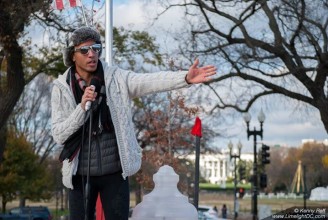
Installation artist Michael Verdon from Virginia built a floating effigy burn on his college campus at George Mason University as part of his undergad thesis project. Covered enthusiastically by local media and attended by hundreds, his burn was cited as an example by D.C. lawyer-Burner-organizer Roman Burns, who helps coordinate the playa camp I AM U and applied for the Catharsis permit from the U.S. Park Service.
Other organizers closely connected to the drug policy reform community invited allies attending a national conference in Washington the same weekend. Adam Eidinger from Stop, Drop, and Roll (a camp within the Something Freaky This Way Foams village) and Dr. Bronner’s Magic Soaps lives and works in D.C. He worked with Natalie Lyla Ginsberg in Oakland, who works with MAPS (the Multidisciplinary Association for Psychedelic Studies), as well as Lex Pelger from Brooklyn and others working with Psymposia.
Their outreach helped expand the networks involved in Catharsis. Non-profit organizations, including Students for a Sensible Drug Policy (SSDP) and Law Enforcement Against Prohibition (LEAP), participated in the event. Several speakers in town for a Drug Policy Alliance conference also visited and presented at Catharsis.
Equally impressive was the collaboration across the Burner community in and around D.C.
Regional coordinator Darrell Duane set up a 60-foot dome donated by Camp Contact, which served as the dance floor on Friday night and a space for people to snuggle on Saturday. He also brought a tent that served as an art gallery with images from artists across the city curated by D.C. artist Rosina Teri Memolo.
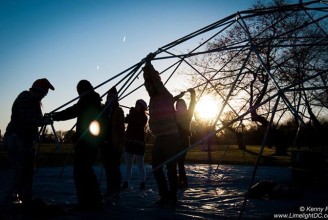
Stop, Drop, and Roll set up outdoor space heaters to keep participants warm, and also built a liberty pole, the likes of which attracted early recruits to the American Revolutionary Army recruited by George Washington before the founding of the Republic.
The Zendo Project staffed a chill space for people requiring counseling or quiet. The Deadly Muppets contributed infrastructure. Finally, Meso Creso (which, in the interest of full disclosure, has included your humble correspondent for six years) supplied the sound system, our DJ booth built from the beadazzled chassis of a Mack truck, and several musicians for the event, including me and my musical mentors V:shal Kanwar, Sequoia, and Synz.
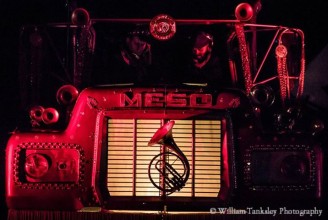
Organizer Kate Bell (a.k.a. Monster) noted that Catharsis “combined my two favorite things: drug policy reform and the Burning Man community. Drug policy reform is the issue I am (trying to) devote my career to, and the Burner community is the foundation of my social life. I have often wished that my activism and my Burner life were more integrated.”
Natalie from MAPS described feeling “extraordinarily encouraged by how easily Burners were able to embrace and connect over social justice, and recognize how imperative it is to bring our Burner values home to the places where we live every day.“ She added, “The intersection of the social justice and Burner communities is destined to do beautiful things.”
Contrasting the event to others in terms of its remarkable accessibility to the public, organizer Adam Eidinger explained, “When we host a free burn for the public, it’s the ultimate non-commercial experience and is 100% inclusive. Burns with no admission fee, no alcohol and in a public place are more inclusive, significant to the default world and unusually safe compared to burns with alcohol.” He said, “To have a burn for a cause seems more important culturally and politically significant than a burn for a ticketed audience. Our proximity to the White House and Capitol Building allowed powerful art to speak truth to policy makers.”
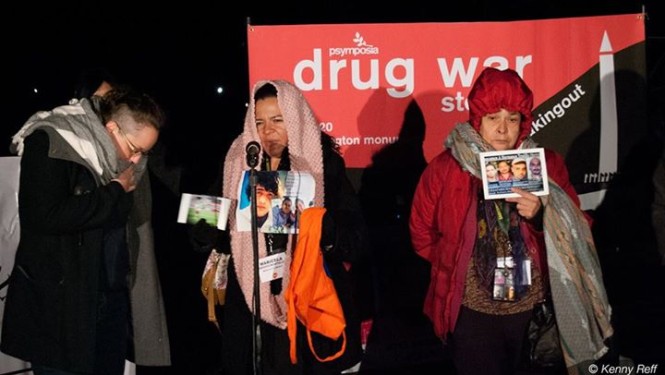
Art and Activism
Catharsis started with a symposium on Friday, bringing together voices from across the hemisphere to discuss how U.S. drug policy has affected their countries, communities, and families. Several mothers discussed the disappearances of sons, some abducted and conscripted by narco trafficking syndicates, others disappeared by their own local government in retaliation for their peaceful activism, and many more coerced by fear and intimidation into silence.
Others spoke about how existing drug policy has enabled mass incarceration, driving the imprisonment of millions of Americans for supposed “crimes” that have no victims.
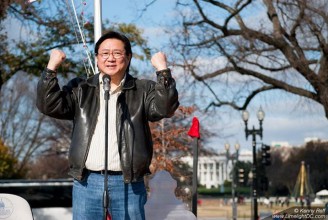
Sanho Tree from the Institute of Policy Studies connected the international dots, explaining how the War on Drugs fuels poverty, despair, and alienation around the world. He shared stories from places where drugs are grown, like Colombia, where eradication and fumigation efforts have destroyed crops and entire rural economies while undermining food security. He also addressed challenges in the places where drugs end up, like Baltimore, noting how both the supply and demand sides of the Drug War suffer from it in different ways.
I also presented among the speakers at the open mic. My remarks suggested that, beyond unconstitutional ethnic profiling and race-biased sentencing disparities, the War on Drugs has also promoted institutional corruption. For instance, police departments across the country contrive prosecutions to seize assets from accused traffickers without having to ever prove their guilt. Meanwhile, the Drug Enforcement Administration has used National Security Agency intelligence to illegally prosecute drug crimes while lying to courts about the origins of the evidence. I also went into the historical origins of the War on Drugs, highlighting the documented involvement of the CIA in international cartels, which helped escalate the crisis in the first place.
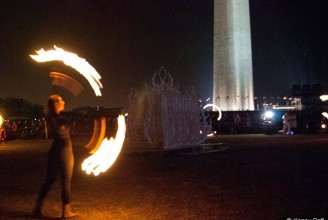
Hearing stories from so many different cultures helped illuminate how much our respective struggles share in common. The parallel experiences that speakers shared helped bring people together even before the event shifted into a phase of ecstatic celebration.
Friday was the coldest night D.C. had seen since this spring, driving participants from outside under the monument into the dome contributed by Burners from Camp Contact. I had a chance to reconnect with Big Will, whom I first met on the playa this year at Something Freaky This Way Foams, where we both camped and played music. We traded DJ sets until the generator ran out of gas, when the appearance of light in the eastern sky invited whomever remained to rest for a few hours.
On Saturday, thousands of participants over the course of the day witnessed an open mic, art installations, and more talks continuing the symposium, before music in the early evening, the effigy burn in the late evening, and then more music until dawn.
They included random passers-by sucked in by the music or visuals, every Burner crew in D.C., and individual Burners and drug policy advocates from as far away as New York, Tampa, and San Francisco.
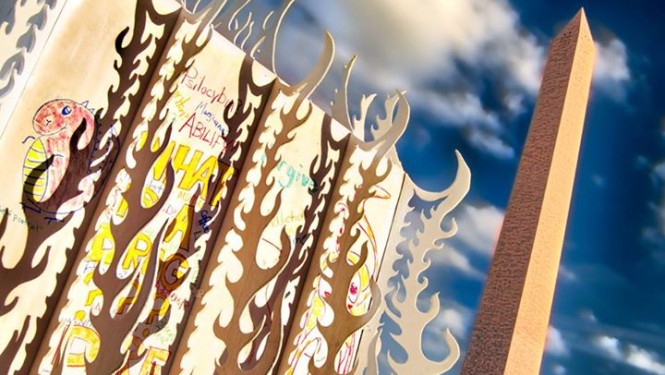
The burn itself was profound. Designer Michael Verdon, whose floating effigy burn at George Mason University helped pave the way for Catharsis, engaged the event’s themes in his construction: the temple burned down to a frame evoking a jail cell before falling to the ground. Its flames were visible from the White House.
Asked about the effigy’s imagery, Michael said, “I suggested that we make the temple reflective, and everyone agreed. The interior space of the object was created to prompt empathy through experience. It facilitated a lot of healing in that space. Many people are still living these traumas. For them, I hope we raise awareness and can tear down the racist divide. I look forward to keeping a conversation about individual and communal healing and transformation alive.”
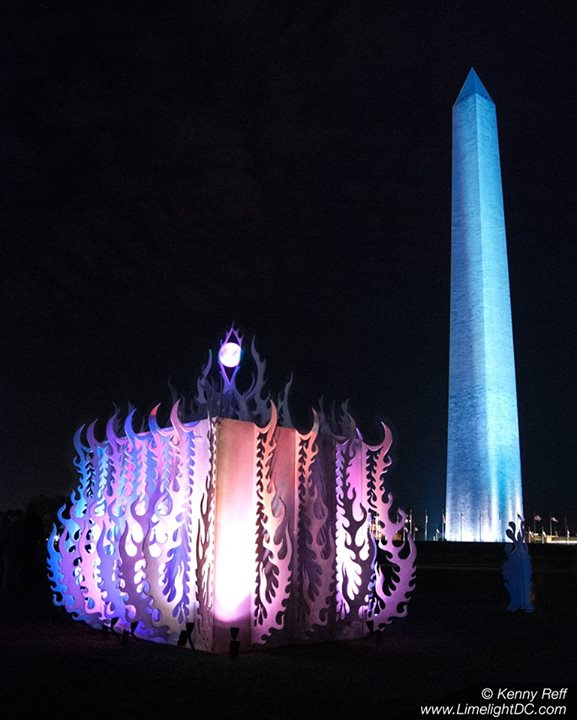
It’s All About the People
Describing the weekend’s powerful fusion of elements, Natalie shared her hope that “Catharsis helps illuminate the healing power of celebration,” and explained that “Our vision with Catharsis was to… elevate art’s central role in collective healing… by cathartically dancing until sunrise, sharing our most painful stories, and burning interactive art installations!”
Both Kate and Natalie shared compelling observations about inclusion and diversity. Natalie explained that “Catharsis, like Burning Man, was predominantly white, which is especially problematic because the War on Drugs is disproportionately waged on communities of color.” She added, “Though we as Burners might view ourselves a conscious community, we have a lot of racial-consciousness-raising left to do before we will be a safe space for people of color.”
Kate echoed those sentiments, noting, “[Although] we did have a lot of diversity among the speakers… I would have liked to see much more diversity among the attendees at the burn. This is always a problem at Burner events. In this case, the police presence required by having an event on the Mall could have been a turn-off for some people.”
As always in our gatherings, the most memorable aspects involved seemingly random moments and spontaneous conversations. Perhaps because the event drew participants from across numerous overlapping social circles, the quality of interaction and quantity of new meetings were both as high as I’ve seen them anywhere, including in the desert.
Shortly after the burn, two men approached me while I was catching up with some friends from Meso Creso, ostensibly to pet my faux fur coat. They mentioned that they worked “a block away,” and that they found their way to Catharsis more or less spontaneously. Their introduction suggested few possibilities, all of which involve some sort of government service, so my friends and I were eager to engage them in a wide-ranging conversation.

We discussed the civil rights violations pervading the Drug War, the ways intelligence agencies use the Drug War as a pretext to deploy resources across the western hemisphere, popular disappointment in the Obama administration, and its legacy of entrenching and expanding on the Bush administration’s assault on constitutional rights and the separation of powers. They discussed the difficulties of getting anything done in Washington and demonstrated remarkable patience in responding to our concerns.
Had that conversation happened inside the White House, or in a congressional office building, I doubt they would have proven so open to so challenging a dialogue. The space, however, invited openness: they spoke of the wisdom they saw in our gathering, which struck them even in passing. Originally attracted by a visual spectacle, they grew impressed not only by Burner aesthetics, but also by our communities’ principles and our enthusiastic willingness to embrace anyone.
Catharsis was indeed cathartic. The event brought together participants from across the hemisphere with others from across the neighborhood, and built a celebration on the ashes of a painful (and still enduring) chapter in our nation’s history. Catharsis was also inspiring, enticing numerous networks to converge in pursuit of a shared vision vital to our cultures, as well as the world beyond us.
Fortunately for those who missed this year’s launch, organizers have already announced plans to put together another edition of Catharsis in 2016. To get involved, leave a comment letting them know how to find you, and think about whether your community could host a similar event where you live.
Top photo by Kenny Reff

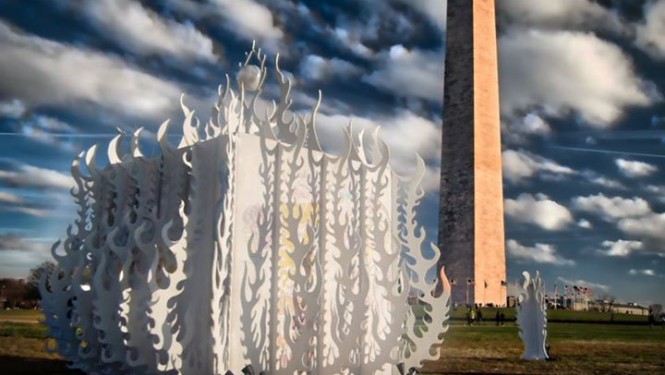
Beautifully written article about the event. Thank you for sharing the amazing culture of DC.
Bless up DC!!!!
Report comment
Even though I was very peripherally involved in helping pull this together, I’m really impressed by the depth of this article and all of it’s references. I learned a lot. Thank you!
Report comment
Side note: The atmosphere on burn night was surreal. It had the feel of a true Burn, with all of the love and community and respect and fire and excitement one would expect. And they got away with this on the National Mall! WTF??? {{{Hugs}}}
Report comment
would love to participate next year
Report comment
It was a very enlightening experience. Healing, educational and cathartic. Let’s do it in Boston.
Report comment
Great Article. Can you mention the dates that it occurred?
Report comment
Would love to participate next year!
Report comment
A live recording of my DJ set from Catharsis is online at https://www.mixcloud.com/shahid-buttar/shahid-buttar-playing-catharsis-on-the-national-mall-in-dc-11212015/
The mix starts out downtempo, before moving into funky, tribal, dreamy, conscious deep house featuring a few samples from the good Rev. Dr. Martin Luther King, Jr. and “Move Any Mountain,” released by the Shamen nearly 25 years ago.
While this recording doesn’t include my live vocals, my “From Ferguson to Jerusalem” lyrics were captured on YouTube at a Meso Creso party this spring (at https://m.youtube.com/watch?v=IKTqyWubrHk), while my song, “green out of the pockets of politicians” was recorded at the PEX summer music festival (at https://m.youtube.com/watch?v=efeoVUZpawA).
Report comment
Thanks!…..sorry I missed Catharsis…..it sounds beautiful……want to join in/help next year!!
Report comment
Chronic
Report comment
I am sad to have missed this & would love to get involved in the next one!
Report comment
Thank you, Shahid, for giving sustaining life to our glorious inaugural event through your epic write-up. I’ve shared it so many times (another time just now in fact). How many hats can one man wear so damn well? That’s my question for Shahid Buttar this evening, ladies and gents.
Report comment
Comments are closed.